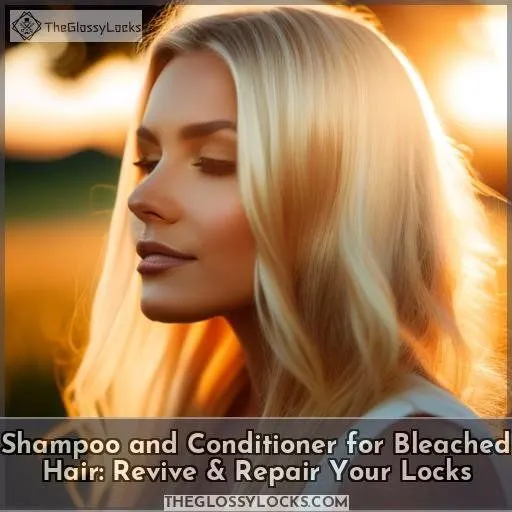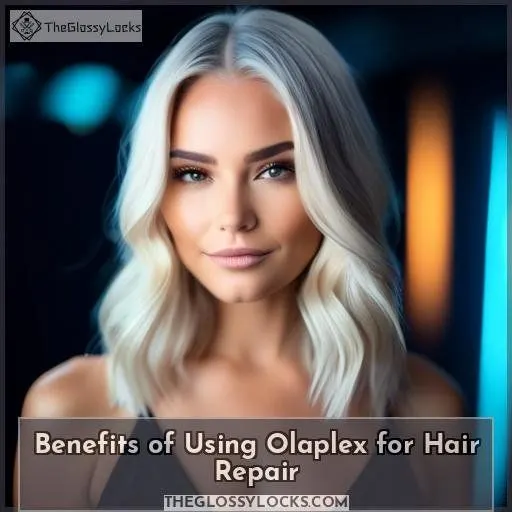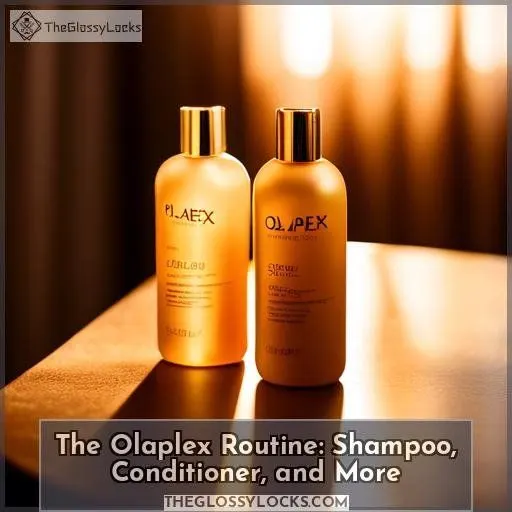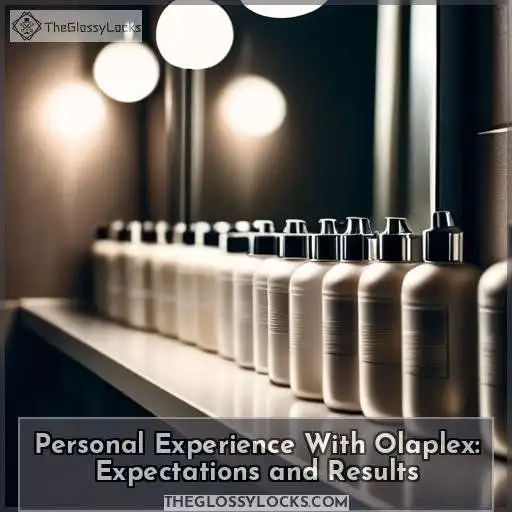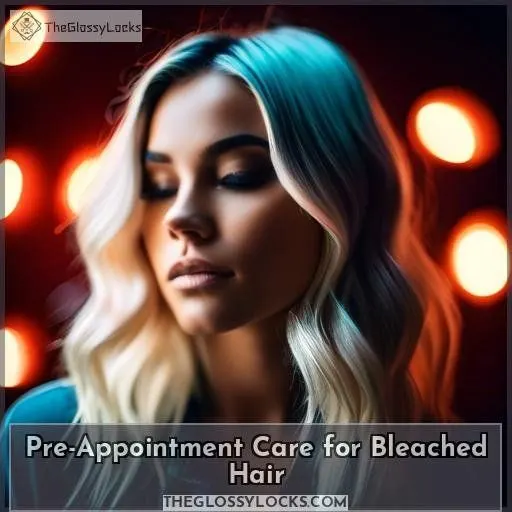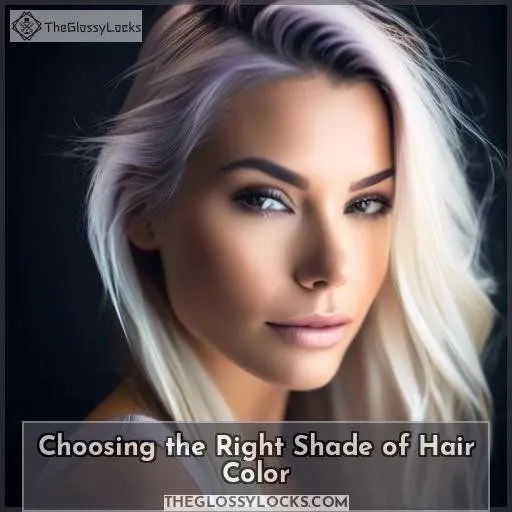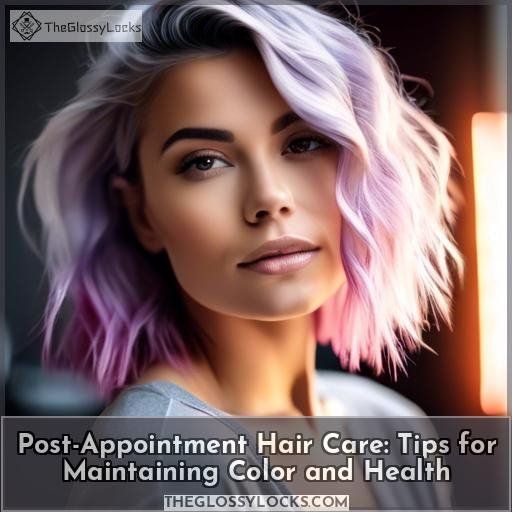This site is supported by our readers. We may earn a commission, at no cost to you, if you purchase through links.
For bleached hair, you need to revive your locks with the Olaplex shampoo and conditioner.
These products are specially formulated to repair disulfide bonds, reverse damage from bleaching, and prevent future breakage.
Olaplex replenishes moisture, adds shine, and improves manageability – transforming dry, brittle strands into soft, luscious tresses.
Whether you have fine or thick hair, this bond-building system is suitable for all textures.
Consistent use will strengthen hair while protecting against color fading.
To achieve the best possible results and learn tips for maintaining vibrant, healthy bleached hair, let’s explore the Olaplex routine in depth.
Table Of Contents
- Key Takeaways
- Understanding Olaplex: a Bond Builder for Bleached Hair
- Benefits of Using Olaplex for Hair Repair
- Who Can Benefit From Olaplex Treatments
- The Olaplex Routine: Shampoo, Conditioner, and More
- Personal Experience With Olaplex: Expectations and Results
- Pre-Appointment Care for Bleached Hair
- Choosing the Right Shade of Hair Color
- Initial Color Appointment: What to Expect
- Post-Appointment Hair Care: Tips for Maintaining Color and Health
- Frequently Asked Questions (FAQs)
- Conclusion
Key Takeaways
- Olaplex shampoo and conditioner are specifically formulated to repair disulfide bonds and reverse damage from bleaching.
- These products are suitable for all hair types and textures, and can improve manageability, add shine, and prevent future breakage.
- Olaplex products are available at various retailers, including Nordstrom, and are priced between $14 and $28 per 3.3 ounces or 8.5 ounces.
- Consistent use of Olaplex products can strengthen hair and protect against color fading.
Understanding Olaplex: a Bond Builder for Bleached Hair
Olaplex is a bond builder that works to repair disulfide bonds in hair, which are crucial for maintaining the well-being and strength of your locks. It’s particularly beneficial for bleached hair, as bleaching can cause considerable damage to the hair’s structure. By repairing these bonds, Olaplex helps to restore the natural luster and suppleness of your hair, preventing further damage from bleaching, dyeing, and heat styling.
Olaplex is available in various products designed for different stages of hair care. These include shampoo and conditioner specifically formulated for bleached hair, such as Olaplex No. 4 and No. 5, which are rich in nourishing ingredients and leave-in treatments like Olaplex No. 6 and No. 7, which provide additional moisture and protection.
The advantages of using Olaplex are noticeable, with users reporting improved hair health, reduced damage, and increased shine and manageability. It’s also recommended for all hair types, not just bleached hair, making it a versatile choice for anyone seeking to improve their hair’s overall health and appearance.
Olaplex products are priced between $14 and $28 per 3.3 ounces or 8.5 ounces and are available at various retailers, including Nordstrom. To achieve optimal results, it’s crucial to maintain a consistent hair care routine, including regular use of Olaplex products and regular haircuts to maintain the health of your hair.
Benefits of Using Olaplex for Hair Repair
You’re no stranger to the damaging effects of bleaching your hair – brittleness, breakage, and dryness galore. Olaplex is here to reverse that damage and bring your locks back to life. Its unique bond-building formula not just protects your strands from future color trauma but also repairs and strengthens hair that’s already been through the wringer.
Protects hair from color damage
Olaplex is a game-changer for hair protection**, offering benefits that go beyond just repairing damaged hair.
With its unique technology, it protects your hair from color damage, preserving the strength of your hair and preventing further damage.
By using Olaplex, you can maintain the health and vibrancy of your hair, even after bleaching or coloring.
It’s not just about repairing the damage; it’s about preventing it from happening in the first place.
So, whether you’re looking to keep your hair healthy or want to extend the life of your color, Olaplex is the way to go.
Makes hair stronger and healthier
Olaplex benefits go beyond the surface, fortifying your locks from the inside out. Embrace the transformation to stronger, healthier tresses as this hair care maestro turns back the clock on damage. With each use, you’re not just maintaining hair color; you’re investing in the resilience of your strands, ensuring your hair’s health is as vibrant as its dye.
Reverses damage from bleaching
Olaplex is a game-changer for bleached hair, reversing damage by repairing bonds and restoring structural integrity. It’s not just about moisture retention; it’s about split end reduction and even hair loss prevention. Your hair care routine becomes more effective when you incorporate Olaplex. It’s a must-have for blonde hair and damaged hair, ensuring your locks stay healthy and vibrant.
dyeing
Dyeing your hair can cause damage, but Olaplex is here to help.
This bond builder is designed to repair the disulfide bonds in your hair that are broken during the coloring process.
By using Olaplex, you can maintain the color of your hair and prevent it from fading.
It’s not just about repairing damage; Olaplex also adds shine and makes your hair more manageable.
Plus, it’s suitable for all hair types, including colored hair.
So, if you’re looking to preserve the strength of your hair and keep it healthy, Olaplex is the way to go.
and heat
Protein treatments are paramount for hair repair, particularly for bleached hair that’s impaired from heat and chemical treatments. These treatments function by replenishing protein into the hair shaft, fortifying the strands and minimizing breakage. They’re especially advantageous for individuals with porous hair, those who’ve experienced chemical services, or those struggling with lifeless hair that fractures easily.
A protein treatment can also enhance the appearance of your hair, making it healthier and more resilient. Regular use of protein treatments can hinder excessive frizz, promote moisture retention, impart elasticity to the hair, and enhance shine.
In addition to protein treatments, leave-in treatments, hair masks, and deep conditioning can also be beneficial for hair repair. Heat protectants are also critical for maintaining hair health, especially when using heated styling tools.
To maintain healthy hair, it’s imperative to equate protein treatments with moisture treatments, as both are necessary for optimal hair health. Depending on your hair type and concerns, you may want to use a protein treatment periodically, followed by a deep conditioner to achieve the ideal balance.
Who Can Benefit From Olaplex Treatments
If you’re someone who’s bleached, colored, or heat-styled your hair, you might be looking for ways to restore its health and shine. Olaplex, a popular hair care brand, offers a range of products designed to repair damaged hair and protect it from further damage. Whether you have fine or thick hair, curly or straight, Olaplex can benefit you. It’s not just for bleached hair; it’s also suitable for colored hair, split ends, and even natural hair.
For those with brown hair, Olaplex can help maintain its richness and depth. It’s also great for long hair, as it can prevent breakage and promote growth. If you have thick hair, Olaplex can help manage its volume and keep it healthy. It’s even beneficial for curly hair, which tends to be more prone to damage and dryness.
The Olaplex Routine: Shampoo, Conditioner, and More
Olaplex is a game-changer for those with bleached hair, offering a two-step in-salon treatment that repairs disulfide bonds and adds moisture to compromised hair.
But what about daily hair care?
The Olaplex routine includes shampoo and conditioner (No. 4 and 5), a deep conditioner (No. 8), a leave-in conditioning treatment (No. 6), and a bonding oil (No. 7).
For those with fine or straight hair, the Olaplex shampoo and conditioner are specifically designed to detangle and soften without weighing down the hair.
Once a week, use Olaplex purple shampoo (No. 4p) to maintain blonde color.
For hair growth, incorporate the bond builder (No. 3) once or twice a week.
Finally, apply the leave-in conditioning treatment and bonding oil after every wash to lock in moisture and protect from heat damage.
With regular use, expect healthier hair and improved hair care for bleached hair, straight hair, fine hair, and short hair.
Personal Experience With Olaplex: Expectations and Results
You’ve bleached your locks to the high heavens, and now they’re crying out for a lifeline.
Enter Olaplex, your hair’s new best friend. With sky-high expectations, you’re looking for results that scream ‘hair mastery,’ and Olaplex doesn’t disappoint.
It’s not just a quick fix; long-term use turns straw-like strands into silk. Think of it as the affordable option that sidesteps the need for drastic bleaching alternatives like hair extensions or, heaven forbid, a hair transplant.
And while it’s not a magic potion for hair removal, it’s a knight in shining armor for your bleached tresses.
So, whether you’re battling the oil slick or rocking the brunette vibes, Olaplex is the secret sauce in your hair care arsenal.
Pre-Appointment Care for Bleached Hair
Bleaching your hair can be harsh and damaging, but with the right pre-appointment care, you can safeguard your locks and guarantee a successful coloring session. Here’s a four-step guide to help you prepare your hair for the best results:
- Moisturize with a protein-rich conditioner: A protein-rich conditioner helps to strengthen and fortify your hair, making it more resilient against the effects of bleaching. Apply the conditioner to your hair, focusing on the ends, and leave it on for a few minutes before rinsing.
- Use equalizing solutions to reinforce hair porosity: Equalizing solutions help to balance the porosity of your hair, assuring that the color is evenly distributed. Apply a small quantity of the solution to your hair before toning or before wrapping permanent wave rods. Don’t rinse it off.
- Add extra conditioner before dye application: Applying an extra layer of conditioner before dyeing your hair can help to protect it from the chemical process. This will help to prevent breakage and assure that your hair is well-nourished.
- Consult with your colorist for personalized advice: Your colorist can provide you with specific recommendations based on your hair type, color goals, and previous damage. They may suggest additional steps or products to help you achieve the best possible results.
Choosing the Right Shade of Hair Color
When selecting a new hair hue, it’s essential to evaluate your skin’s undertones and how various shades will harmonize with them.
Preserving your hair color also entails choosing a tint that aligns with your desired maintenance schedule. Cool tones generally demand less frequent touch-ups, while warm shades necessitate greater upkeep as roots appear.
For individuals with textured hair, it’s vital to recognize how your hair’s nature can influence the intensity and durability of specific colors.
Skin Tone and Undertones
To find the ideal hair color that harmonizes with your skin tone, it’s crucial to discern your skin’s undertones. Undertones are the subtle shades beneath your skin’s surface, and they’re unaffected by exposure to sunlight. There are three primary categories of undertones: cool, warm, and neutral.
Cool undertones are distinguished by hints of blue, pink, or red, while warm undertones tend towards peachy, yellow, or golden hues. Neutral undertones combine both cool and warm hues. To determine your undertone, examine the color of your veins under natural light. Blue or purple veins indicate cool undertones, greenish veins suggest warm undertones, and veins that blend with your skin indicate a neutral undertone.
Once you have identified your undertone, you can select hair colors that complement it. For cool undertones, ash and icy tones are ideal, while warm undertones look great with warm golds and caramels. Neutral undertones can be paired with a diverse range of colors, as they aren’t as closely associated with a particular undertone.
It’s important to remember that these are broad guidelines, and personal preferences and style should also be taken into consideration when choosing a hair color. Additionally, it’s always wise to seek advice from a professional hairstylist for a personalized recommendation based on your skin tone and undertones.
Hair Color Maintenance
Maintaining your blonde hair color can be a challenge, but with the right products, you can keep your locks looking vibrant and healthy. Olaplex offers a range of products designed specifically for blonde hair, including the No. 4P Blonde Enhancer Toner Shampoo, which is enriched with concentrated pigments to neutralize and correct harsh brassy tones, leaving your blonde brighter than ever.
To keep your hair color looking fresh, follow these tips:
- Cleanse and tone: Use the Olaplex No. 4P Blonde Enhancer Toner Shampoo to cleanse and tone your hair in one step. A little goes a long way, so massage a small amount of product into your hair and rinse thoroughly.
- Nourish and replenish: After shampooing, use a nourishing, moisture-rich treatment like the Olaplex No. 8 Bond Intense Moisture Mask to soothe hair weakened by chemical processing. This mask features the same bond-building technology as other Olaplex heroes, designed to leave bleached strands feeling soft, strong, and manageable.
- Take breaks from purple shampoo: While the No. 4P purple shampoo is great for maintaining blonde, it’s important to take breaks from it. Instead, use the No.4 Bond Maintenance Shampoo to freshen and fortify your strands without stripping your color.
Color Selection for Curly Hair
When selecting a hair color for curly hair, consider factors like hair porosity, blonde maintenance, root touch-ups, and color oxidation.
Curly hair tends to absorb color faster than straight hair, so choose a shade that complements your skin tone and undertone.
For low-maintenance options, play on natural tones.
If you’re going blonde, be prepared for significant damage and cost.
Consult with a colorist for advice on the best shade and maintenance expectations.
Initial Color Appointment: What to Expect
Commencing your initial color appointment, you’re embarking on an adventure to metamorphose your tresses.
Following an in-depth consultation with your stylist, wherein your hair aspirations are unveiled, the enchantment commences.
Color application is a craft, and your stylist is the artisan, artfully harmonizing shades to align with your vision.
Anticipate the session to extend 2-5 hours, a modest sacrifice for the masterpiece that lies ahead.
Glossing methodology plays a fundamental role, infusing depth and radiance, while root touch-ups guarantee a seamless fusion with your innate color.
As time elapses, anticipation intensifies.
Bear in mind, patience yields exceptional results, and your forbearance will be rewarded with a captivating new appearance.
Post-Appointment Hair Care: Tips for Maintaining Color and Health
After your initial color appointment, it’s essential to sustain your hair’s health and vibrancy. Here are some pointers for post-appointment hair care:
- Use sulfate-free, color-conserving shampoo: Sulfates can strip your hair of color, so choose a sulfate-free shampoo to keep your color looking fresh.
- Color-boosting hair masks: Apply hair masks that deposit pigments to your hair, helping to maintain the color.
- Matching eyebrow makeup: Consider matching your hair color to your eyebrow makeup for a cohesive look.
Frequently Asked Questions (FAQs)
How often should I trim bleached hair?
You’ll want to trim your bleached locks every 6-8 weeks to snip off those pesky split ends. Think of it as a mini makeover – a fresh cut to keep your mane looking as fierce as you feel!
Can natural remedies help repair bleached hair?
You could slather your hair in mayo and pray to the hair gods, but natural remedies won’t undo bleach’s bond-breaking wrath. Embrace the damage, champ – a bond rebuilder like Olaplex is your only savior.
Are there any vegan options for bleached hair care?
You’re in luck! Brands like Olaplex, Kevin Murphy, and Pureology offer excellent vegan haircare for bleached tresses. These plant-based formulas gently restore moisture and rebuild those broken bonds, reviving your locks’ vibrant health.
How does swimming affect bleached hair?
Swimming can wreak havoc on your bleached locks. Chlorine and salt water cause dryness, brittleness, and color fading. Protect your ‘do by wetting hair before diving in and using a deep conditioning mask post-swim. Embrace mermaid vibes responsibly!
Can diet influence the health of bleached hair?
Sure, say your friend went vegan – their hair would likely become drier and more brittle from lack of protein. A balanced diet with lean meats, veggies, and healthy fats keeps bleached hair strong and shiny. You’re what you eat, after all.
Conclusion
Ultimately, nourishing your bleached hair with the Olaplex shampoo and conditioner holds the key to restoring your luscious locks. By fortifying disulfide bonds and replenishing moisture, this bond-building system will transform dry, brittle strands into soft, vibrant tresses. Consistent use won’t only reverse existing damage but also provide protection against future breakage, ensuring your colored hair remains healthy and radiant.

